
Christmas in Sweden, 1:48 scale
In Swedish, Christmas is called Jul (an ancient Germanic word; cf. English "Yule"). Our equivalent of "Merry Christmas" is God Jul (roughly pronounced "Good Yule", which is exactly what it means).
The celebrating of Christmas in the Western world has changed a lot in the last 200 years. For example, Christmas trees didn't really catch on outside Germany until well into the 19th century. On this page, I'm trying to give a sample of Swedish Christmas traditions, both from the 19th century countryside, and of today's traditions that were formed during the 20th century.
Christmas at a 19th century farm
In the 19th century the industrial revolution had only just reached Sweden. The majority of the Swedish population were farmers, crofters, farmhands, and so on, so in focusing on farms I'm actually talking about the average Swedish household of the time.

One special thing about Christmas, was that the floor of the house was spread with straw for all of the holiday season, and people were playing games in it. The straw could also be used to make ornaments, like a straw mobile with little bits of fabric included for color, and figures like the straw goat shown here. This tradition lasted into the late 19th century, when spreading straw on the floors became prohibited due to the fire hazard.
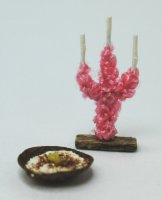
In some areas, wirework was a wide-spread cottage industry in the 19th century, producing items like bread prickers, egg whisks, and the "skeleton" of this candleabra. People who bought the candleabra wrapped them with a bubbly cut paper fringe, for a festive appearance. Back then, ornaments were way more generic than today - used for any festive occasion, rather than tied to a particular season.
A bowl of the boiled rice pudding would be set out outdoors for the little tomte living at the farm (he would aid or thwart your work depending on how you treated him). Here, it's served with cinnamon and a dollop of butter. Boiled rice pudding has long been a traditional dish for special occasions. Before rice imports started in the 18th century, native grains were used instead (but it was still cooked with milk, rather than water like in porridge).
Traditional Christmas food food
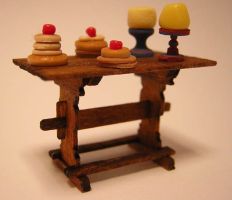
Much of the Christmas food was based on pork - pigs were at their fattest before Christmas, as they'd been gobbling up acorns in the forest during Autumn, so it was the best season for pig slaughter.
In the Middle Ages, lutfisk was served on Christmas Eve, as fish was fasting food, and Christmas Eve was the last day of the pre-Christmas fast. Then ham was served on Christmas Day - the first non-fasting day. Sweden became a Protestant country in the 16th century, but this tradition hung on in various degrees through the centuries.
In Swedish farmhouses and cottages, up to about 1900, every family member got a julhög ("yule pile") on Christmas Eve. This was a pile of various types of bread for eating during the holiday season, and it might be topped with e.g. an apple or a pretzel-shaped bun. Butter was proudly displayed on a tall turned wooden plate painted in bright colors.
Christmas tree
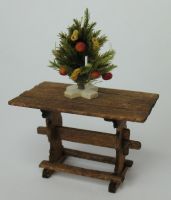
Christmas trees started to become common in farmhouses around the mid-19th century; manors and parsonages had them a bit earlier. At first they used to be small size trees, suspended from one of the ceiling beams. Later they were placed on a table instead. In either case, they were decorated with edibles - in this case, apples and pretzel-shaped saffron buns.
The X-shaped wooden stand is typical of the 19th century and a few decades into the 20th. The tree wouldn't last very long without water, but spruce seem to drop their needles quickly whatever you do.
By the year 1900, full-size trees had become more common, sporting glass baubles, tinsel garlands and home-made ornaments.
The Yule Goat (Julbock)

Between Christmas and New Year, young people dressed up as weird characters, including a goat, and went from house to house asking for food and funds for their joint Christmas party. In the 17th and 18th centuries, attempts were made to ban the pranks involved. The origins of the goat character can't be traced for sure, but it may stem from a furred devil with horns that accompanies Saint Nicholas in European tradition.
In the 18th century, upper class families started having a goat character, the julbock, bring them Christmas presents. The julbock would wear a ragged coat or a sheepskin thrown over his shoulders, and a goat mask or goat head made from e.g. straw or wood. This tradition eventually spread to the farmers as well.
The julbock tradition lasted into the late 19th century, and in the early 20th century it was still a well-known concept.
It was superseded by the jultomte, a vague cross between the international Saint Nicholas/Santa Claus character and the Scandinavian tomte tradition.
I doubt that the julbock bringing gifts was quite as common the jultomte is today - at any rate, traditions tended to vary a lot more from area to area before the advent of mass-media.
Doll in the collection of Pam Scott.
Christmas in the 20th century and on
In most lines of work, 'Eve' days are days off, and have been so for several decades. Earlier on, people worked on Christmas Eve and started celebrating in the evening. This was still the case in the 1930s when my grandmother was a child.
Advent
The Christmas season in Sweden begins with Advent - the four Sundays preceding Christmas Day. As the days are short in Sweden at this time of the year (at Stockholm's latitude, we have about 6 hours of daylight), most people light their windows with electric candelabra and paper star lights in the windows (both were introduced in the 1930s). Christmas trees are seldom put up before Christmas.
Lucia
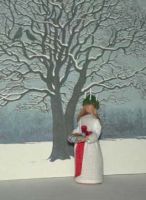
On Santa Lucia Day, the 13th of December, a daughter of the family rises at dawn, dresses in a white gown with red sash and puts a crown of candles on her head. She then wakes the
family members with singing and a traditional Lucia Day breakfast. Santa Lucia always offers saffron buns decorated with raisins, and also gingerbread - see the closeup picture.
Doll in the collection of Marilyn Nielsen.
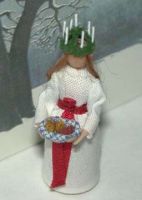
The Lucia Day was originally celebrated in remembrance of the 4th century Sicilian saint Lucia. There's evidence of this custom in Sweden since the 1760s, but at that time it was a regional tradition in manor houses in Western Sweden, Lucia hadn't yet got her crown of candles, and she was serving a more ordinary breakfast. In the late 19th and early 20th century, a newly awakened interest in folk traditions made the Lucia celebrations increasingly popular throughout Sweden.
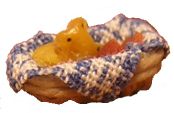
In the late 19th and early 20th century, a newly awakened interest in folk traditions (partly thanks to the recently opened open-air museum Skansen) made the Lucia celebrations increasingly popular throughout Sweden, and this doll shows what a Lucia could look like at that time. By now, many kindergartens and schools in Norway and Denmark have started celebrating Lucia too.
Christmas food
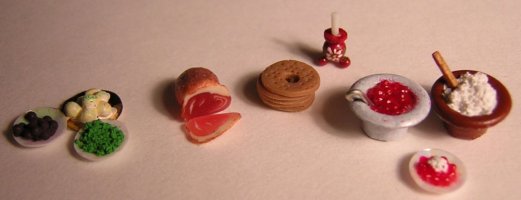
Christmas celebrations begin with the lunch on Christmas Eve. It's served smorgasbord style, and typically includes pickled herring and boiled eggs, crispbread, wort bread, potatoes, ham, sausage, meat balls, etc (some of these are shown in the pic).
If there's a dessert, it'll be Rice à la Malta - boiled rice pudding, cooled, sweetened, mixed with whipped cream and a touch of vanilla. It's served with some type of fruit sauce (here, traditions vary; in my family we have strawberry sauce, as shown). This dish emerged in the early 1900s, as a fancier version of the boiled rice pudding. The name is originally a mis-spelling for Riz à l'amande; a similar Danish dish that included chopped almonds.
Lutfisk (dried whitefish prepared to a jelly-like consistency) with potatoes and white sauce is often served on Christmas day or the day after.
Christmas tree
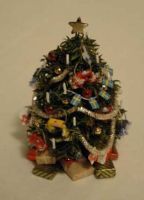
I based this rather traditional Swedish Christmas tree on how my mother dresses her tree, though I simplified it by using only the largest and the most characteristic ornaments. Later I've tried to check up in books and photographs how long the these types of ornaments had been used, and was surprised to find that this tree could arguably fit a 1905 setting (with the reservation that the style of the crackers has changed a little bit since then - at least up to the mid-1900s, they used to be hung vertically rather than horizontally, and had less "fringe" at the top end). My directions for making the ornaments were published in the LEN magazine.
I've made another, similar, tree that is in the collection of Pamela Scott.
In the late afternoon or early evening of Christmas Eve, the jultomte will visit, handing out the gifts -
both the ones he brings in his sack, and any gifts placed under the tree.
Candlestick
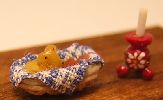
This Christmas candlestick design has been popular since the early 20th century, always painted bright red. At first it was just a solid red without ornamentation, but eventually the white flower became a standard feature.
I included Lucia's basket of saffron buns and gingerbread in the pic to show the size.